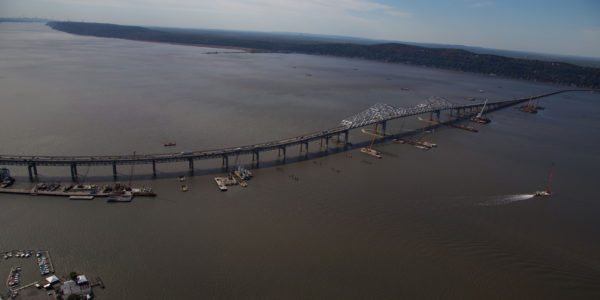
- An aerial view of the replacement bridge being constructed alongside the Tappan Zee Bridge.
Photo courtesy New York State Thruway Authority
A federal appeals court ruling could bode well for Westchester and Rockland commuters as they brace for sticker shock over toll prices on the Tappan Zee Bridge replacement.
The U.S. Court of Appeals Second Circuit issued a ruling Dec. 23 that said resident-specific discounts for tolls on bridges such as the Verrazano-Narrows Bridge did not violate the Constitution. The majority of funding has yet to be decided upon for the $3.9 billion twin-span replacement bridge and the current $5 cash toll is expected to at least triple to offset the gap.
The three-judge appeals court ruling sets a precedent that a resident discount on the new Tappan Zee could withstand a legal challenge, although it remains to be seen if Gov. Andrew Cuomo and the state Legislature would pursue such a discount. Cuomo”™s administration remains tight-lipped on estimates for impacts on the new toll, although the governor and state Thruway Authority have clung to their pledge not to raise other tolls in the system to offset the construction cost.
Paul Feiner, the supervisor of the town of Greenburgh, said in a recent letter to the Business Journal that downstate residents”™ fees often pay for upstate infrastructure work. “Yet, when it comes to the new Tappan Zee Bridge only downstate commuters will be paying for the bridge via the toll increases,” he said. “If the state insists on only charging downstate for the new bridge, the Thruway Authority should not charge Westchester and Rockland commuters for work on the roads that is being done north of Orange County.”
Feiner is among local elected officials who have suggested residents of the region should get discounts similar to those reviewed in the December appeals court ruling. The ruling upheld a lower court”™s 2013 decision over a lawsuit from residents of New Jersey and elsewhere who sued the Triborough Bridge and Tunnel Authority, saying a resident discount violated “the right to travel” clause, which requires out-of-state visitors be treated as welcome guests on equal footing as residents. The lower court ruled that offering residents a discount didn”™t impose on the travel rights of nonresidents.
The Verrazano currently has a $15 cash and $10.66 E-ZPass toll, but Staten Island residents with E-ZPass pay a discounted rate of $6 or $6.36 depending on how often they use the bridge. A recent agreement endorsed by Cuomo reduced the Staten Islander rate to $5.50. The court also upheld discounts for Rockaway and Broad Channel residents in Queens who use the Marine Parkway and Cross Bay bridges.
A residential discount at the Verrazano has been baked into state law since 1995 under the administration of Gov. George Pataki, according to the daily newspaper The Staten Island Advance.
Westchester County Executive Rob Astorino was “pleased” with the recent court ruling, according to spokesman Phil Oliva. Oliva said that if the toll increases on the new Tappan Zee, Astorino would support a discount for Westchester commuters with the amount of the discount based on how often they use they bridge.
Yet for the hopes of a similar discount for Westchester or Rockland residents, the basis of the appellate court ruling was “geographical isolation” as outlined in a previous case regarding toll discounts in the upstate community of Grand Island, an island community on the Niagara River. Local commuters are likely to have a more difficult time proving similar geographical isolation to Grand Island or even Staten Island and Rockaway. The only other direct connection between Rockland and Westchester is significantly north of the Tappan Zee, away from the main travel routes of lower Westchester and unable to accommodate similar levels of traffic: The Bear Mountain Bridge. That bridge has a toll of $1.50 cash or $1.25 for E-ZPass.
Speculation over the new Tappan Zee toll has increased as construction continues with only a $1.6 billion U.S. Department of Transportation loan committed to date. Last month, Rockland and Westchester”™s county executives, Ed Day and Astorino, called on the state to use half of a $5 billion settlement with investment banks to help fund the construction.



















